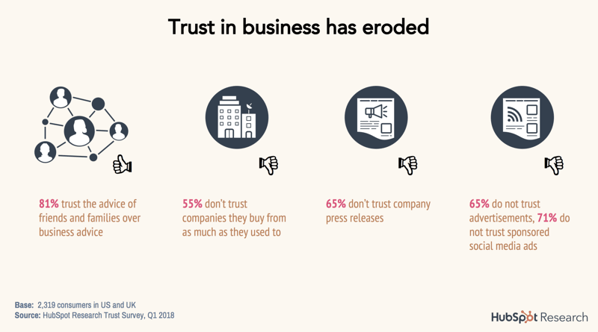Having an acquisition strategy that works for your business means striking the right balance between increasing not just the volume, but also the quality of your leads, and their likelihood to convert into customers of your product/service.
While it may be tempting to jump straight into growing your leads and traffic, you need a more considered approach - in today's saturated playing field, customers are not so easily won over nor kept.
The stats show that marketing is getting more expensive as industry incumbents become increasingly pay-to-play, and also that customer trust levels are on the decline as audiences are inundated with sponsored or irrelevant content every day.
 The erosion of trust can be especially damaging to your acquisition strategy, where costs are high and there's no second chance to make a first impression.
The erosion of trust can be especially damaging to your acquisition strategy, where costs are high and there's no second chance to make a first impression.
At alphawhale we've helped eCommerce brands improve their acquisition strategies through attracting more of the right customer - that is, a customer with a strong lifetime value.
Through our approach and research, we've spotted some of the acquisition mistakes that marketers tend to easily slip into. If you want to keep your customer acquisition strategy healthy and in-check, make sure to avoid these common missteps:
Firstly, be clear on your product/market fit.
No matter how incredible your marketing strategy might be, it needs to be backed by the right product or service for your customers. In fashion eCommerce, this might mean having stylish, well-designed clothes made from quality materials. Whatever the case; there is no purpose in having a killer customer acquisition strategy if your product is not going to solve the needs of the market.
On that note; poor quality photos, images or videos of your products will most likely send buyers away too. If you have a great product, you need even better images of it.
Next, figure out your Customer Acquisition Cost (CAC).
If you're already achieved product-market fit, then the next step is to calculate your Customer Acquisition Cost or CAC. Without knowing your CAC, there is no real way to gauge whether your marketing ROI is positive or not.
One simple way to calculate your CAC is to divide all the costs spent on acquisition (marketing, sales, overheads, salaries of marketing and sales staff, cost of tools, PPC etc.) by the number of new customers you gain over a fixed period of time i.e. weekly CAC, monthly CAC or annual CAC. To learn more about this, what your customer acquisition cost says about your business.
Revise your current acquisition channels and consider if you're trying to be in too many places at once.
Most marketers focus on ruthlessly minimising their Customer Acquisition Costs, while trying to be present on as many channels as possible, which are two goals that can often contradict each other.
Unless you have a huge team, deep pockets and the luxury of time, this approach will not work for you - you're far better off identifying high value channels and allocating more resources into those, at the expense of trying to show up everywhere for the sake of it.
Want to learn more about this? Check out our post on the acquisition channels you need to be focusing on.
Finally, some of the most common acquisition mistakes you should be avoiding:
1. Not understanding what the customer's priorities are.
Without knowing what your customer prioritises during their awareness/consideration phrase, you are transferring the responsibility of knowledge back onto them and assuming that they'll magically have everything they need to commit to purchasing.
We see this kind of approach as the cause behind a lot of marketing bad-practice, such as:
- Assuming the customer's hierarchy of needs without conducting research to back it.
- Assuming every first-time customer or visitor will turn into a loyal customer.
- Focusing on features that aren't essential to the customer/focusing on too many features rather than just a few key benefits.
- One-size-fits-all marketing messages used across all channels.
- Focusing on the wrong acquisition channels/wasting budget.
It takes time and research to recognise the needs of your different audience segments and their decision-making process. The only way you can break through the noise and engage your customer is by understanding what they need and presenting it back to them simply, clearly and without - they shouldn't be expected to come running just because you've published a new ad or written a new sales email.
2. Heavily relying on price-driven acquisition tactics.
Building brand equity matters infinitely more than discounting. Even if your product comes at a bargain price, brand equity still matters! Think of McDonald's - they have built a complete and sustained culture around their brand, and because of this they rarely need to tout that their burgers are low-cost.
It may be tempting (especially in eCommerce) to pursue "quick wins" for the quarter through heavily discounting your products. And that does work - at first. You will see a spike in sales. But the problem is, customers who flock to your business because of lowered pricing are not your ideal customers.
Here's an example; the now defunct cleaning service Homejoy enjoyed incredible growth by offering deep, deep discounts for first-time buyers. Yet this method of acquisition played a major role in their subsequent collapse - they were acquiring the wrong kinds of customers, and most of them never returned for a second purchase.

It pays to know who your ideal customers are and what they want from your business. If your acquisition strategy revolves around attracting those core users and solving their pain points, you're much less likely to face retention issues like Homejoy did later on.
The best way to keep your ideal customers top-of-mind is to create buyer personas backed by research - there's more on buyer personas here.
3. Giving up on a lead too soon/not having a lead nurturing strategy.
Here's a staggering fact: 96% of customers who come to your website aren't ready to buy yet.
Most of your website visitors are still in the consideration phase of their journey; they'll research your products and brand but aren't looking to make an instant decision. That doesn't mean they won't purchase later down the track - it just means they might purchase from your competitor, if they have a better lead nurturing strategy than you.
That spells out only one thing - you cannot take your visitors or leads for granted!
At alphawhale, we see huge opportunities for improvement in how businesses communicate to their leads - not just through messaging but also by medium. This is backed by Hubspot, who state that the best multi-channel lead nurturing commonly involves a mix of:
- Marketing automation
- Email marketing
- Social media
- Paid retargeting
- Dynamic website content, and
- Direct sales outreach.
Even if you've added a couple of these extra customer touchpoints to your acquisition strategy, you'll likely notice a significant uplift in your conversion rate.
So it you haven't considered this already, it could be time to diversify your lead nurturing strategy and add a new abandoned cart email series, retargeting campaign or even shooting a second sales email through to someone who clicked on your first email.
Similarly, know what kind of leads are truly worth a followup. Score them based on their willingness to buy, and spend a little more time nurturing your top leads.
4. Blowing your first impression.
"Buyers make most decisions by relying on their two-second first impressions based on stored memories, images and feelings."
- Malcolm Gladwell, Blink: The Power of Thinking Without Thinking
We live in a world where first impressions last. How a customer ultimately perceives your business comes down to their first impression of your store location, website appearance/navigation, social media posts, customer service and more. This is not solely about having the right look or branding, it's about the experience that you want a customer to have and how you can instil that message into every single touchpoint.
Always strive to make a killer first impression and experience, whether it be through your:
- Website messaging and ease-of-use
- Social media, blog and PPC content
- Onboarding process
- Physical/digital customer service and complaints handling process
- Email marketing
- Sales calls
You can change a customer's perception of your brand over time and with new information, but never take the first impression for granted. Focus on where you can be adding value to their experience and doing it in a way that stays true to your brand.
Curious? Furious? Intrigued? We’re always happy to share our knowledge of digital marketing and have a chat about your business. Come on over, we’ll have coffee.





